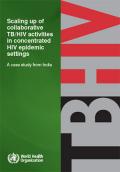Publications - Released in 2015
India has a high burden of both tuberculosis (TB) and HIV, and faces a high burden of HIV-associated TB. While TB is endemic, the HIV epidemic is concentrated in a few states. A national response to TB epidemic was initially integrated in the general health system through the revised national TB control programme. This differed from the staggered response to the HIV epidemic under the national AIDS control programme, where programmes were initiated in high HIV burden states and gradually expanded to the rest of the country. Over the past decade, the HIV epidemic in India has expanded to historically low prevalence settings. However, this increase was not met by increased local programme capacities, and this situation created hurdles for rapid scale-up of collaborative TB/HIV activities and gaps in the detection and treatment of HIV and HIV-associated TB. Facilitated by the joint national TB/HIV policy, national TB and HIV programmes have systematically addressed these gaps and succeeded in reducing the incidence, prevalence and mortality due to TB, HIV and HIV-associated TB.
This case study documents the experience of the scale-up of collaborative TB/HIV activities in India over the past decade, exploring the challenges encountered and the steps taken by national TB and HIV programmes collectively to address them. The key lesson learned from this experience is that collaborative TB/HIV activities can be scaled up successfully in concentrated HIV epidemic settings if TB and HIV programmes share ownership of TB/HIV interventions.
Organizations
- World Health Organization (WHO)






